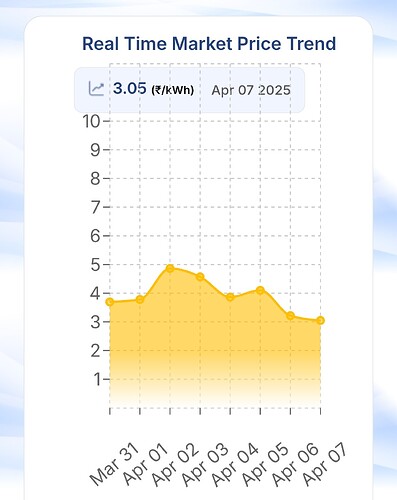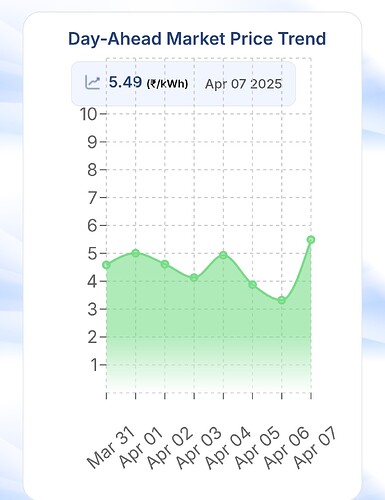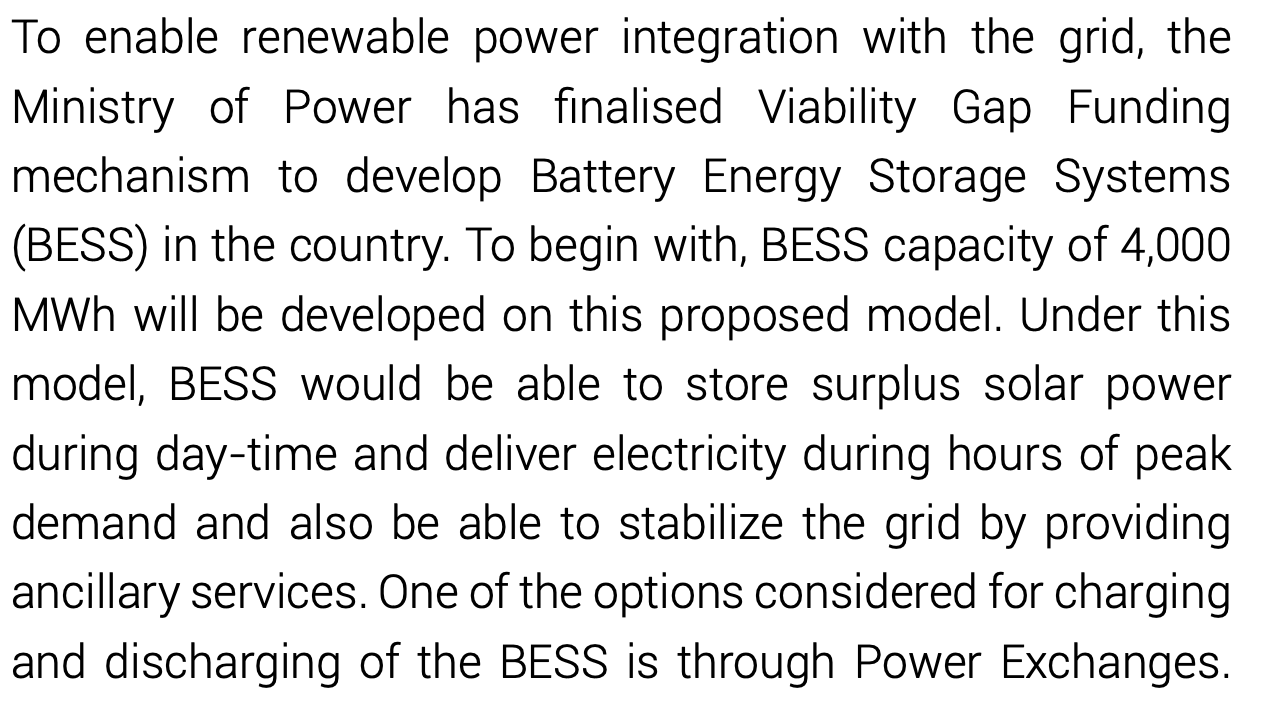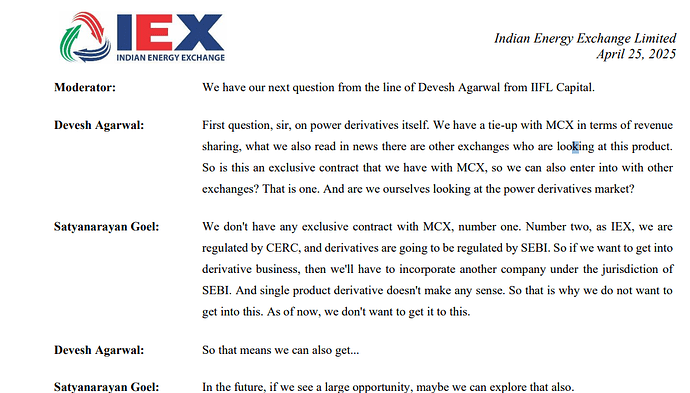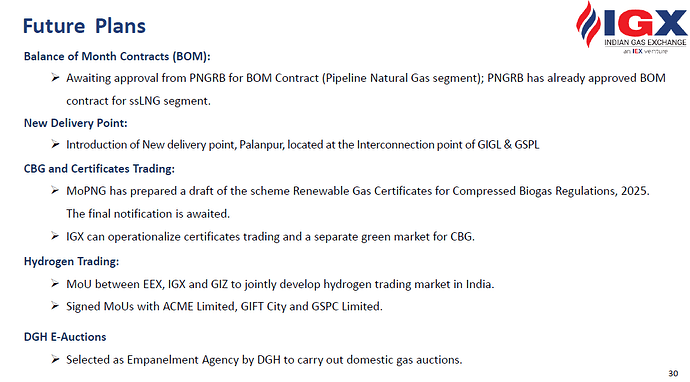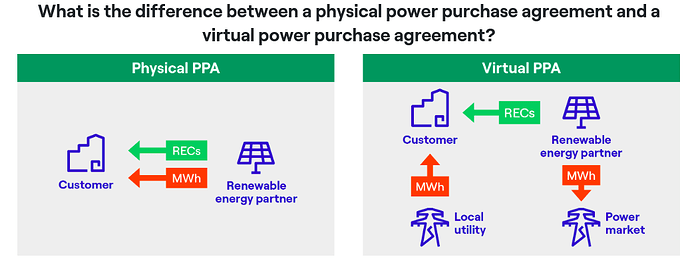This has basically turned into an issue of exchange coupling now. While it has its pros, It’ll be difficult to implement + as the management and the study pointed out, the return on this whole implementation will be minuscule.
Even after this, if CERC plans to go ahead with this. I’m sure it’ll take them more than 3-5 years to implement this.
Was going through there website what’s the difference between DAM and RTM and can one tell the percentage of volume traded between them.
And for electricity generation company point of view should one look for DAM or RTM prices?
Hi @sumit_kumar,
The difference is that in the Day Ahead Market (DAM), the buyer and seller agree a day in advance about the delivery of power. On the other hand in Real Time Market (RTM) the buyer and seller agree an hour in advance about the delivery of power.
For the year ended FY24, DAM was 48.5% of overall volume traded on IEX and RTM was 27.3%. You can check this on Page 23 of FY24 annual report.
It depends on a couple of factors.
First is, what is the price you are getting in RTM or DAM. As a power generation company you would always want to sell at the higher price.
But the second and more important factor is source of power generation. If you are generating power using coal or nuclear energy then you can switch to DAM from RTM and vice versa depending on the price. After all, you can be pretty confident that you would have power to sell tomorrow too at the time being asked by the buyer.
However, if you are a solar or wind energy company then you don’t really know if you would have power to sell tomorrow. It depends on whether the sun shines or the wind blows tomorrow. So you are more likely to use the real time market to sell the power you generate.
May be once battery storage of energy becomes cheap and easy, renewable companies can also choose whether to sell DAM or RTM depending on the price. See the excerpt below from Page 7 in FY24 annual report
Can IEX help out India metal & infra companies exporting to EU on the CBAM front?
As the companies will be paying heavy duties even with FTAs & BTAs
Why Spot Power Prices Dropped to Zero on IEX & what does this mean for the business
Recent reports indicate that real-time electricity prices on the Indian Energy Exchange hit record lows, dropping to near-zero levels in multiple time blocks (specifically from 9:15 AM to 2:30 PM) on May 25, 2025. This was driven by a combination of factors:
- Unseasonal Rains and Reduced Demand:
Unexpected rainfall and thunderstorms across regions like Delhi-NCR, Himachal Pradesh, Rajasthan, Gujarat, Kolkata, and Bengaluru lowered temperatures, significantly reducing electricity demand. Lower demand meant less need for power purchases on the exchange, pushing prices down.
- Surplus Power Supply:
Increased generation from hydro, wind, and thermal sources created an oversupply of electricity. This surplus, combined with reduced demand, led to a glut of power available on the IEX, causing prices to plummet. The average price in the Real-Time Market (RTM) for May 1-24 was ₹3.66/unit, a 23.4% year-on-year drop, with near-zero prices recorded on May 25.
- Increased Sell-Side Liquidity:
Sell-side liquidity on the IEX rose by 43% year-on-year during the first five days of May 2025, as more power was offered for sale due to stable fuel supplies and government measures like the operation of imported coal-based and gas-based plants. This further pressured prices downward.
Is This Negative for IEX?
The near-zero spot power prices are not necessarily negative for IEX in the long term, but they present a mixed impact:
- Short-Term Impact:
Revenue Pressure: IEX earns transaction fees based on the volume of electricity traded, not the price per unit. However, extremely low or zero prices could discourage trading activity if sellers (generators) find it unprofitable to sell at such rates, potentially reducing volumes temporarily.
Higher liqudity = lower prices = higher exchange volumes (only if demand and supply match)
- Long-Term Perspective:
Volume Growth: IEX’s business model benefits from high trading volumes, which have been strong despite low prices. The 26% YoY volume growth in April and 19% in FY25 suggests robust market participation, driven by increased supply liquidity and government policies supporting exchange-based trading.
Sources:
This article is applicable to any power/electricity related business. If this rhymes with Indian context, expect a lot more electricity to be traded (volume), and as a leader IEX - due to 80+% market share, as of now, will benefit.
MBED - one country one price - continues to remain an overhang.
What are the implications on IEX? Will this only provide as a tool to hedge for participants? Was there a plan for IEX to launch LT derivatives as well? Apparently MCX, NSE, IEX as well approached earlier for approvals from SEBI, and seems this is the first such approvals, and may more to follow…
The primary issue in electricity derivatives was which regulator will oversee it. SEBI and CERC went to Supreme Court which ruled that any trade involving physical delivery of electricity is governed by CERC and only money exchange is governed by SEBI. As a result an exchange being governed by SEBI could launch derivatives. If I remember correctly, IEX management mentioned in previous conference calls that they will not launch derivatives.
I am not sure how it will impact IEX especially the longer term contracts. IEX and MCX did sign a licensing agreement in 2020 for MCX to launch derivatives using spot prices on IEX. Need to find out if it is still valid, if it was approved by regulators and if yes, what benefits it will bring to IEX.
Disc - invested in IEX
Until Mar’25, the monthly electricity traded volume used to be a sum of DAM, RTM, TAM, G-DAM & G-TAM. However, for the last two months it is NOT matching. In Apr’25, I get 10,545 MU whereas the report has 10,584. In May’25, I get 10,879 and the report has 10,946. Anyone knows the reason?
Power Market Update - 2025-05.pdf (576.3 KB)
Power Market Update - 2025-04.pdf (604.3 KB)
If MCX uses IEX spot price data, can we assume, IEX would reap a share from the profit earned by MCX through those derivative contracts, at no extra cost? Also, considering bulk of the power trading happens on IEX and hoping more and more participants would want to hedge through derivatives, it should turn into a positive self-fueling cycle of increasing power trades happening on IEX platform. Is that a fair projection?
Disc: Invested and possibly biased, seeking validation of investment thesis.
CNBC TV18 mentioned today that MCX will pay 10% of it’s commission to IEX for spot rates. I have not independently verified this.
Apart from these fees, derivatives I would think will deepen the power markets further, which should help IEX.
Market coupling could be a spoiler here though.
disc - invested.
Please cite the source next time, otherwise that’s an unsubstantiated comment.
This video talks about 2 triggers for IEX, one is the 10% revenue sharing from MCX on the transactions and the second is the possibility of NSE also entering this.
why IEX cannot have derivatives? Not able to understand the logic.
Future Plans of Indian Gas Exchange (IGX)
The Indian Gas Exchange (IGX), a subsidiary of the Indian Energy Exchange (IEX), is poised to play a pivotal role in India’s growing gas market. With the government targeting an increase in natural gas’s share in the energy mix from 6% to 15% by 2030, IGX is introducing innovative initiatives to enhance trading efficiency, expand market access and support cleaner energy solutions. Here’s a breakdown of IGX’s future plans:
- Balance of Month (BOM) Contracts
What it is: BOM contracts allow buyers and sellers to trade natural gas for the remaining days of a month, offering flexibility to manage short-term needs.
Update: IGX has received approval from the Petroleum and Natural Gas Regulatory Board (PNGRB) for BOM contracts in the small-scale LNG (ssLNG) segment. Approval for pipeline natural gas BOM contracts is pending.
Why it matters: These contracts enhance market flexibility, enabling participants to optimize gas procurement and respond to demand fluctuations, boosting IGX’s trading volumes.
- New Delivery Point at Palanpur
What it is: IGX is adding Palanpur, located at the interconnection of Gujarat Gas Limited (GIGL) and Gujarat State Petronet Limited (GSPL) pipelines, as a new delivery point for gas trading.
Why it matters: Expanding delivery points improves access to gas for buyers in new regions, increasing market liquidity and making IGX a more attractive trading platform.
- Compressed Biogas (CBG) and Renewable Gas Certificates Trading
What it is: The Ministry of Petroleum and Natural Gas (MoPNG) is finalizing the Renewable Gas Certificates Regulations, 2025 for CBG, a renewable fuel produced from organic waste. IGX plans to launch a dedicated green market for CBG and certificate trading.
Why it matters: CBG trading and certificates align with India’s sustainability goals, attracting environmentally conscious investors and supporting the government’s push for cleaner fuels. This could open a new revenue stream for IGX.
- Hydrogen Trading Market Development
What it is: IGX has signed Memorandums of Understanding (MoUs) with the European Energy Exchange (EEX), GIZ, ACME Limited, GIFT City, and Gujarat State Petroleum Corporation (GSPC) to develop a hydrogen trading market in India.
Why it matters: Hydrogen is a key pillar of India’s clean energy transition. By creating a trading platform for hydrogen, IGX positions itself as a leader in the emerging green energy market, potentially capturing significant market share.
- Directorate General of Hydrocarbons (DGH) E-Auctions
What it is: IGX has been selected by the DGH as an empanelment agency to conduct e-auctions for domestically produced natural gas.
Why it matters: This role enhances IGX’s influence in the domestic gas market, allowing it to facilitate transparent and competitive price discovery, which could drive higher trading volumes and revenue.
The market is concerned about regulatory challenges like market coupling and oversight impacting IEX’s core power exchange business. However, IEX’s subsidiary - IGX is innovating with new products and positioning itself as a dynamic player in India’s gas market. They are many optionalities in the business of IEX.
Can IGX become the next IEX?
Source: Latest Presentation
I had mailed this query to IEX. I got a call from Aditya Wali, Manager, Investor Relations and he confirmed that the delta is due to High Price Day-Ahead-Market (HP-DAM) and High Price Term-Ahead-Market (HP-TAM). These were 39.6 and 67.4 in Apr’25 and May’25 respectively. They don’t report this as the volume is minuscule.
IEX: Quiet Tailwind from New VPPA Regulations ??
The Central Electricity Regulatory Commission (CERC) has proposed new rules to introduce Virtual Power Purchase Agreements (VPPAs) in India.
These are financial contracts that let companies buy green power virtually, locking in long-term prices while receiving renewable energy certificates (RECs) to meet ESG or compliance goals.
Unlike traditional power purchase agreements, where electricity physically flows from a generator to the buyer, a virtual PPA does something different. It doesn’t interfere with the actual electricity infrastructure you’re plugged into: it’s a purely financial contract.
Impact on IEX:
-
Price Benchmarking: VPPA settlements rely on spot market prices, where IEX serves as the key reference. This strengthens IEX’s role in electricity price discovery.
-
Higher REC Volumes: VPPAs use RECs to validate green claims. This could drive more trading activity on IEX’s REC platform.
-
Boost to Green Segments: IEX’s Green Day-Ahead and Term-Ahead Markets may see increased volumes as renewable energy procurement becomes easier and more flexible.
-
Future Optionality: If VPPA contracts become standardized, IEX could develop a dedicated trading platform, similar to its expansion into carbon and gas markets.
The VPPA framework is still in draft stage, but it opens up a new layer of financial infrastructure in India’s power sector where IEX is well-positioned to benefit.
Zerodha Daily Brief #253 video

